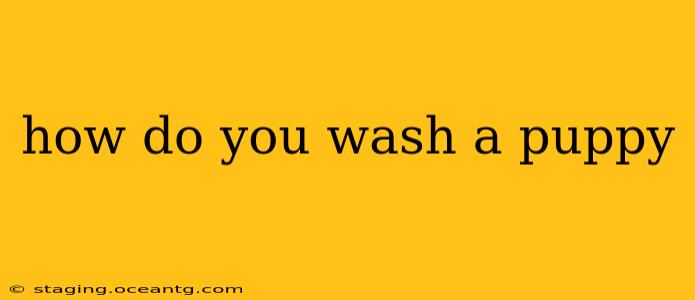Washing a puppy for the first time can feel daunting, but with the right approach, it can be a positive experience for both you and your furry friend. This comprehensive guide will walk you through the process, addressing common concerns and ensuring a gentle and effective bath.
Why Wash a Puppy?
Before diving into the how-to, let's address the why. Regular bathing is crucial for maintaining your puppy's hygiene and overall health. It helps:
- Remove dirt and debris: Preventing matting and skin irritation.
- Eliminate unpleasant odors: Keeping your puppy smelling fresh and clean.
- Prevent parasite infestations: Reducing the risk of fleas, ticks, and other unwanted guests.
- Maintain a healthy coat: Promoting shine and preventing dryness.
What You'll Need:
Before you begin, gather your supplies. Having everything ready will make the process smoother and less stressful for your puppy:
- Puppy-specific shampoo: Avoid human shampoos, as they can dry out your puppy's skin.
- Warm water: Too hot or too cold can be uncomfortable.
- Towels: Several large, absorbent towels are essential.
- A non-slip mat: For the bottom of the tub or sink, preventing slips and falls.
- Optional: A cup or jug: For rinsing, especially helpful for smaller puppies.
- Optional: Cotton balls: To gently clean sensitive areas like the eyes and ears.
How to Wash Your Puppy: A Step-by-Step Guide
-
Preparation is Key: Brush your puppy's coat thoroughly before the bath to remove loose fur and tangles. This prevents matting and makes washing easier.
-
Wetting Your Puppy: Gently wet your puppy's fur with warm water, avoiding getting water in their ears or eyes. Start from the neck and work your way down, using a cup or jug to control the water flow.
-
Applying Shampoo: Apply a small amount of puppy shampoo, working it into a lather. Massage gently, avoiding harsh scrubbing that could irritate their skin. Pay extra attention to areas that tend to get dirtier, such as the paws and tail.
-
Rinsing Thoroughly: Thoroughly rinse all the shampoo from your puppy's coat. Any residual shampoo can irritate their skin. Use a cup or jug to ensure complete rinsing.
-
Drying Time: Wrap your puppy in a towel and gently blot their fur to absorb excess water. Avoid rubbing vigorously, as this can be uncomfortable and damage their coat. For smaller puppies, you may need several towels. You can use a hairdryer on a low, cool setting if your puppy is comfortable with it, keeping it at a safe distance.
How Often Should I Bathe My Puppy?
This depends on your puppy's breed, coat type, and activity level. Generally, bathing every 4-6 weeks is sufficient for most puppies. However, more frequent baths might be necessary if your puppy gets particularly dirty or muddy.
What if My Puppy Hates Baths?
Many puppies dislike bath time. Make it a positive experience by associating it with treats and praise. Keep the bath short and sweet, focusing on making it as comfortable as possible. If your puppy becomes overly anxious, you can consult with your veterinarian.
How Do I Clean My Puppy's Ears and Eyes?
Cleaning your puppy's eyes and ears requires extra care: Use a damp cotton ball to gently wipe away any dirt or debris from around their eyes. For their ears, only clean the outer ear flap, using a damp cotton ball or ear wipe designed specifically for dogs. Never insert anything into your puppy's ear canal.
What Kind of Shampoo Should I Use?
Always choose a shampoo formulated specifically for puppies. These shampoos are gentler on their delicate skin and less likely to cause irritation. Avoid human shampoos and harsh chemicals.
Can I Use Baby Shampoo on My Puppy?
While some people might suggest baby shampoo, it's still advisable to use a puppy-specific shampoo. Baby shampoos are not always pH-balanced for a dog's skin, and they may still dry out their skin.
My Puppy Keeps Getting Dirty; What Should I Do?
Frequent cleaning may be necessary if your puppy enjoys rolling in mud or playing outside frequently. Regular brushing and spot cleaning between baths can help minimize the need for frequent full washes.
By following these steps and addressing your puppy's individual needs, bath time can become a less stressful and even enjoyable experience for both of you. Remember, patience and positive reinforcement are key to success!
